Every year, for the past five years, the Experience Design community, now part of AIGA, gathers together for two days to think about the state of the profession and to have conversations around a particular aspect of the world in which Experience Design lives. The summit happens each year as a check point to the profession.
Despite the state of the economic climate today, there was a good showing. Many attendees were from California (cheap flights) but there were several folks from as far away as Canada, England and Italy in attendance and there were many new faces in the mix.
The theme this year: Integrating our values, processes, and insights into the business community
The summit began with the traditionally well-attended cocktail hour on Thursday evening, followed by dinner.
Terry Swack, Clement Mok and Nathan Shedroff welcomed the group and initiated the beginnings of conversations by asking a handful of new attendees to share with the group who they are, what they do and why they were attending.
Dinner, which was beautifully presented, finished off with small groups breaking out to gather for drinks and explore Las Vegas.
Friday, July 12, 2002
The first full day of the summit was programmed to provide different viewpoints around the topic of design’s relationship to business. There were a range of speakers from James Woudhuysen, a design forecaster, to Artie Wu, founder of Vividence, to David Rose, professor at Harvard School of Design and principle at Ambient to Lou Rosenfeld, consultant and IA spiritual leader and Peter Morville, Semantic Studios.
Opportunity
James Woudhuysen was inspiring and made some very good points, in particular about fear and the differences between being inspired by users and being informed by them rather than being led by them. This stifles creativity and innovation which are as important to design as creating something useful and usable.
Measuring Value
Following Woudhuysen were three presentations that looked at some practical ways to measure the work of design – in economic terms as well as social, environmental and ethical terms. Allistair Williamson, WebCriteria, Artie Wu, Vividence and Anne Willoughby each presented.
Artie Wu began by asking us to consider the context for measuring ROI. The main thrust of his presentation lay in the premise that if you aren’t on the critical path to success or are and you fail, then you won’t get funded or you are irrelevant. The goals of design and the success of design in making the relationship with business work are inherently tied to whether or not the project you are working on is on the critical path for the project sponsor.
The last speaker on this topic was Anne Willoughby. Her focus was to look at alternative ways to measure the impact and value of design. Environmental and social actions should be important to design as they work with business and in many cases, these factors are as important as the economic factors. There was no real specific example given of how this could or should be done, but the presentation was a reminder to us all that design has a social responsibility as well as a monetary responsibility to the field, to business and to the world.
Redefining the Practice
The second topic of the day was redefining the practice of experience design. The presentations began with Nico Macdonald, Design Agenda, and then replacing Alan Cooper, who was originally scheduled to speak, a roundtable report by Clement Mok and Davis Masten, Cheskin.
Macdonald, a journalist specializing in writing about design and technology, presented some thoughts and observations from many interviews and conversations he has had in the last year.
The practice has seen layoffs and shifts into freelancing and smaller boutique firms being created. Innovation and opportunity are still all around but design as a practice is having to evolve and adapt as clients are more cautious, expecting more for their money and becoming more customer centric. The climate is one of change and adaptation as design figures out its role with business as well as what it needs to learn from other disciplines in order to continue to be a valued member of the team.
The roundtable report by Mok and Masten, was from a dinner that was held a few months ago. The dinner brought together designers, business leaders and other thought leaders including:
- David Liddle
- David Kelly – IDEO
- Paul Saffo
- Susan Rockrise – Creative VP Intel
- Todd Holcomb
- Nancy Hill – Hill Holiday
- Christopher Ireland – Cheskin
- Tahl Roz, Inc magazine
- Ray Riley
They discussed the nature of the economy and the design practice within the business environment. They talked about structural issues, cultural issues, and education. Masten and Mok shared a few quotes from the conversation
“Designers wander around looking around for their higher purpose the way a golden retriever looks for his tennis ball… I just know there’s something here if I could just claim it… like this itch that can’t be scratched” —Paul Saffo
“The more successful the relationship the more able you are to change the conversation to where you need it to go.” —Susan Rockrise
The q&a discussion around this topic offered some interesting models that the field could look into adopting. Analogies to the movie studio production model as well as the union model were offered for discussion as well as thoughts about what exactly the problem was in the first place.
Repositioning the Practice
The final set of conversations on Friday were loosely collected around the idea of repositioning the practice; what changes in thinking, in working, in doing need to happen in order to keep the practice of Experience Design moving forward and vital.
Kicking off the discussion was Peter Morville, Semantic Studios. He put onto the table the notion of Findability as a dimension of Experience Design that offers an interesting and robust opportunity for the design community.
Morville offered several examples of what is not working currently and how adding the layer of findability to the table can create better products. Google, the Flamenco project from Berkeley and others were offered as beautiful examples where findability was in the forefront of the objectives. He challenged the audience to think about this concept —findability equals beauty —in their design work —beyond usability —and to look for this beauty in new places.
Lou Rosenfeld followed with a very pragmatic presentation around organization and organizational structure. He proposed the creation of strong autonomous Experience Design groups at the enterprise level of business. The model for the group would offer a variety of services and solutions and would look to create a centralized vision for long term and short terms needs within a company. He put forth a very well thought out model that not only had practical application but had a built in business model as well. The idea of becoming a more entrepenurial styled organization within a traditional business organization is interesting and may yet prove successful for those with enough clout and vision to pull it off.
The day ended with groups breaking off for drinks, dinner and many of us attending the grandest of all experiences Cirque de Soleil’s “O”.
![]()
Saturday, July 12, 2002
Saturday’s agenda began with an overview for the day and a look back at what the Experience Design group had accomplished over the last year. The CHI/AIGA Forum and the Case Study initiative were the two major undertakings for the last year. There are plans for more case studies, evolving into several different types of cases as well as the new DUX (Designing User Experience) conference that is in planning with CHI and SIGGRAPH. Terry Swack and Clement Mok mentioned that the AIGA is also working on initiatives that represent the process of design rather than the design artifacts. The AIGA-ED initiatives are part of the larger picture of the shifting organization.
Show & Tells
The formal part of the day began with a morning of Show & Tells. Seventeen presenters, one hour and ten minutes, one room with a couple of divider screens and a whole lot of attendees moving back and forth between simultaneous presenters, made for a really interesting and dynamic part of the summit. The presentations were given by Peter Merholz of Adaptive Path, George Olsen of Capital Group, David Shavrick of ModemMedia, Davis Masten of Cheskin and Nathan Shedroff, Gillian Crampton Smith from Interaction Design Institute Ivrea, Molly Wright Steenson of Razorfish, Gilmer Maluyao from the ACTION project, Kristee Rosendahl of Classroom Connect, Julia Whitney from WGBH, Thomas Mueller of Razorfish, Angela Shen-Hsieh and Mark Schindler of S+A Visual I/O, Eric Wilcox, from IBM Research, Molly Rutten from Intel Corp., Julia Stanford of Sliced Bread Design, Sharon Poggenpohl from the Illinois Institute of Design, Chris Jones of Small Pond Studios and Eugene Chen of Aaron Marcus and Associates.
The presentations ranged from conceptual looks at the future of brand (Masten and Shedroff) to the latest project launched at WGBH (Julia Whitney) to the set of deliverables created for a recent consulting project (Kristee Rosendahl) to a scenario and concept presentation pitch to Kodak (David Shavrick) to what’s been going on in the first year at the new Interaction Institute at Ivrea (Gillian Crampton Smith). The presentations were all interesting and the discussion very lively. This was one of the most dynamic and enjoyable parts of the summit because it had to be quick – presenters were given seven minutes to present and three minutes for questions.
Following the Show & Tells, the entire group posed for the traditional group photo, gathering outside into the 110 degree plus weather and then returning inside to talk about the break out section of the day.
Break Out Sessions
Throughout the two days of conversations, presentations and their followup discussions, Swack and Mok, as well as the presenters jotted down themes, questions and big ideas that surfaced, onto large white tablets. In addition, attendees added thoughts and other questions to these pages. At the end of Friday, the planning committee gathered to review the ideas and group them into common themes. These became the topics of conversation for the break out sessions.
Five topics, with discussion facilitators were introduced to the group. The five topics were offered for discussion and the large group was given a chance to choose which topic interested them. The next three hours, including lunch, were spent in these groups. The goal, to come back to the larger group in the afternoon with some ideas, some initiatives and next steps that could be taken on as projects for the AIGA Experience Design group for the coming year.
After the allotted time was up, the groups came back together and presented their thoughts and ideas. There was lively discussion after each as well and it was apparent that this was a favorite of the summit.
1. ROI and development of consistency and standards in descriptions and communication, Allistair Williamson
Highlights:
- You have to care about business results
- We need more, clear, evidence of business results
- We need a framework for linking attributes to business benefits to measurable objectives
- We need research around existing measurement systems
- Business values people who care about their results rather than some just delivering widgets
2. Vocabulary / Criteria to articulate value, Rick Robinson
Highlights:
- First condition for talking about designing.
Saying that something can be a design = thing A can be changed through an intervention
we x to y in order to z - an activities – objects – outcomes
defining product business
reasoning service social
delivering process objectiveswhat makes design design and not meddling?
The way in which you make the choices, the standards and principles that guide the process – the thread that ties the community together - Decisions within the process are informed by the value to the constituent.
(useful, usable, desireable)
Design brings value to the constituent
Design makes decisions based on standards - What do you get by having the design organization that designs
you get capabilities, outcomes, comprehensibility, clarity
The design organization has ability to innovate, to imagine, to deliver something that didn’t exist before - Tell this story clearly to
business
technology
public
press
other professions
3. Redesigning practice and our fit in organizations, Nick Ragouzis
- Design wants to be more effective in
– business
– society
– environment
– greater good - define problem
– can simplify and summarize
– can visualize
– typically generalists
– self perception is a detriment - strengths
– in communication
– different useful toolset
– we are doers, get things done
– able to quickly prototype - weaknesses
– credibility
– lack domain knowledge and common vocabulary
– not conversant in business
– we’re generalists but not necessarily managers - opportunities
– become better known in business and part of business
– can act as change management and change consultants
– act not just as problem solvers but project definers - threats
– design perceived as a commodity
– designers are outsiders – culture is threatening
– brought in too late to really solve problems and then are scapegoats when they dont go well
– internal resources, or incorrect resources brought in – substitutes for us - Plan
– continue to work through this process in the nine areas
– further distill the commonalities
– put in place a plan of action for acting on our learnings
4. Stepping away from the screen – what ideas are out there in this new landscape and what do designers need to know to participate, David Rose
Highlights:
- Questions were to help understand what it means to step away from the screen
- Who has the money to do these things?
- How do we get invited to the table to ask why?
- What skillsets do we need to know to cross these barriers?
- What tools, techniques do we need?
- Technologies, knowledge base?
- How is design positioned to be a critical component in designing products
- Why do we care?
- Positioning Ubiquitous
- The advance of beyond-the-desktop is inevitable. The infrastructure for embedded wireless is nascent which creates important windows of opportunity. The ED community needs to drive the dialog or our role as designers will be limited. Designers need to acquire a new skill set to participate and have a valued voice. And as true advocates for users we can lead the emerging and critical conversation around ethics and privacy.
- How do we help shape these decisions?
- Research topics for ubiquitous
- What is the framework to balance convergence devices and divergence
- Tactical
- Find new partners for this community to learn from and interact with
- Research education initiatives – where should training come from
- Develop a more holistic skills taxonomy and road map for progression. Address deep core skills and wide skills
- Develop a new technology radar system, establish scouting and forecasting roles and publish to the community
- Establish a process and structured format to critique new products
5. Where opportunities for design may lie in the future, Nico Macdonald
Highlights:
- Looked at the areas where there might be opportunity for design in the future.
- Transportation
- Medical
- Education
- Family
- Financial
- Government
- Narrowed down to transportation.
- Looked at the notion of transportation in context of public and private modes.
- Opportunities in a travel scenario might include creation of devices to harness the community of travelers on a plane, messaging between travelers, or the need to broadcast information about the nature of the travel method – are there seats in the full subway car, or the line at the airport check in is 300 people long.
- Future things designers might need to know in this space include traffic patterns, census growth, government initiatives, research and observation about travelers
The breakouts seemed to be one of the favorite activities for the summit, and this attendee wishes they came earlier in the programming. The presentations and discussions fed the breakout, but by the time they actually happened, the group was tired and not as focussed as they were in the morning.
Closing
The summit officially ended after the last of the break out groups presented. Terry Swack and Clement Mok invited attendees who were interested in pursuing some of these initiatives as well as others mentioned throughout the weekend, to join the steering committee meeting happening the next day.
Overall, the summit was informative and offered a lot of high level conversation and discussion around a few key ideas. The need to discuss these ideas and come up with strategies and solutions is important in our industry. The parting mood seemed positive and there are changes afoot in the way these ideas and initiatives are going to be pursued in the next year, which is hopeful. The failings of past summits have been the lack of follow through and the little evidence of practical initiatives that have actually come to pass as advancement for the practice. This year’s discussions and plans are encouraging to look forward to over the coming year.
Books mentioned during the Summit
|
| Erin Malone is currently a Product Design Director at AOL in the Web Properties division. She has been a practicing interaction, interface and information designer since 1993. |

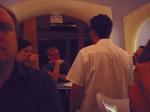
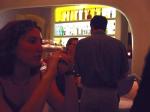
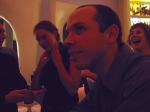
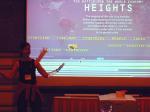
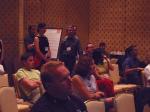
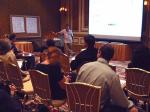
Thanks for the tasty recap, Erin.
Reading about Lou’s presentation really indulged my penchant for organizational design and theory. I see he posted the presentation on his website:
http://louisrosenfeld.com/presentations/
…off I go to check it out. Cheers!
Could someone please get some design sense and change the sky blue color used for hyperlinks? It’s so bloody hard to read! Hasn’t anyone realised that yet? Hyperlinks are supposed to stand out. These practically disappear. They hurt my eyes. Pick a navy blue or something.
I found the photograph of my back very revealing. Thanks the recap Erin.
dave